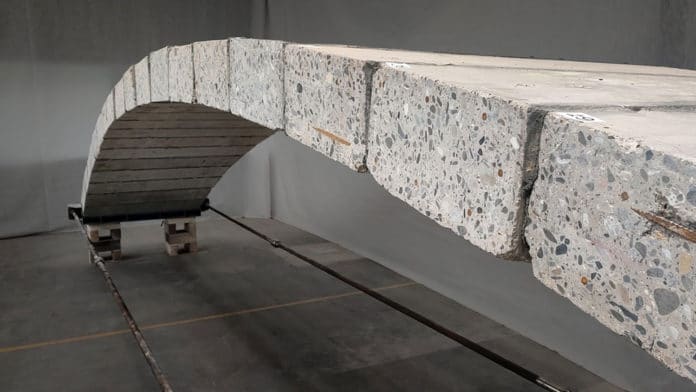The usefulness of concrete does not end when it gets formed into a structure. Old concrete can be reused in several construction projects, depending on the material’s size and shape.
People often hesitate to reuse concrete due to several concerns. But, EPFL researchers have shown that those concerns are largely unfounded.
Using reinforced concrete blocks from the renovated building walls, EPFL researchers have built a footbridge prototype. This project is part of an initiative to substantially shrink the construction industry’s carbon footprint by adopting a circular economy approach.
Researchers built the 10m-wide footbridge by cutting the 25 concrete blocks into individual pieces on site. They then assembled into a prestressed arch.
It is essential to design new methods based on exploiting existing concrete sections to reuse concrete effectively. To help engineers employ these new methods, SXL recently developed a computer program that automates the process of selecting retrieved elements from a given stock and reducing the carbon footprint of a new structure.
EPFL postdoc Maléna Bastien Masse said, “We gave ourselves two months to find a source building in the region and a demolition company that would be interested in working with us. That company turned out to be Diamcoupe, which had been commissioned to renovate a building erected less than ten years ago; this renovation site was the perfect opportunity to viable source blocks of concrete.”
“We asked Diamcoupe to cut the concrete into the sizes we needed and to drill holes through them for our prestressing cables. These cables were provided by Freyssinet and used to build the arch.”
Jan Brütting, a recent Ph.D. graduate from SXL, said, “Arches are the ideal structure for repurposing concrete blocks since the material is only subject to compression forces.”
Corentin Five, a tenure-track assistant professor at EPFL and head of the Structural Exploration Lab (SXL) within the Smart Living Lab, said, “Most buildings in Switzerland are made out of concrete, and producing this raw material accounts for 7% of CO2 emissions from anthropogenic activity. What’s more, concrete makes up 50% of demolition waste. When the material reaches its end of life, it’s at best broken down into gravel or granulate to create recycled forms – but that consumes a lot of energy. If we were instead to cut up concrete blocks and reuse them, we could prevent the need to produce more concrete and eliminate the inert waste. The carbon emissions from this process wouldn’t necessarily be zero, but they would be drastically reduced. We would delay the need to downcycle obsolete concrete.”
“The project is a call to action for the construction industry. No other new concrete footbridge has a carbon footprint as small as ours.”
“Imagine if every obsolete concrete structure out there was cut into blocks and used to meet some of the global demand for new concrete. That would be a big step towards addressing some of the most pressing climate-change challenges.”
The project engineers have finished load-testing the new structure, meaning it’s ready for the inauguration ceremony at the Smart Living Lab’s Halle Bleue on 11 October.
Vernissage: 11 October 2021 at 17:00 in the Atelier PopUp of the Smart Living Lab, at the blue Hall of blueFACTORY, Passage du Cardinal 13b, 1700 Fribourg.
Reference:
- Five C, Brütting J. Nothing is lost, nothing is created, everything is reused: a structural design for a circular economy. Struct Eng. 2020;98(1):74–81.
- Brütting J, Vandervaeren C, Senatore G, De Temmerman N, Five C. Environmental impact minimization of reticular structures made of reused and new elements through Life Cycle Assessment and Mixed-Integer Linear Programming. Energy and Buildings. 2020 May;215:109827. DOI: 10.1016/j.enbuild.2020.109827
- Küpfer C, Fivet C. Déconstruction Sélective – Construction Réversible: recueil pour diminuer les déchets et favoriser le réemploi dans la construction. Zenodo; 2021. DOI: 10.5281/zenodo.4314325
